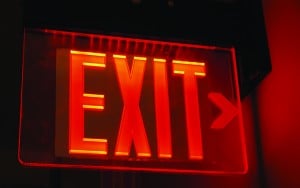
Multi-story commercial buildings are required to have a dedicated exit enclosure designed to withstand fire long enough for people to get out safely. For three story buildings and shorter, the exit enclosure must have a fire resistance rating of at least one hour. An exit enclosure that connects four stories or more must have a fire resistance rating of no less than two hours (there are some exceptions in existing structures).
While these requirements ensure that these stairwells allow for safe egress during a fire, there are also detailed instructions as to what penetrations are permitted (and which are not). If you don't adhere to these, the required “separation of means of egress” won't be achieved, and you'll fail your fire code inspection. So, to avoid the fines and other problems (like inability to get insurance coverage) that come with citations during a fire code inspection, let's take a look at what penetrations you're allowed to have in your exit enclosure.
Allowable Openings/Penetrations
An exit enclosure is supposed to act as a protective shell against any fire in the building. For this reason, you aren't allowed to put openings in the walls or penetrations in the enclosure, except for the following:
- The required exit door openings.
- Certain other types of door assemblies.
The code is detailed on this point, but in most cases you can have a door in the exit enclosure that leads to a mechanical space, if it follows certain requirements. These include not storing combustible materials in the room, and that it be dedicated to housing pipes, ducts, conduits or non-fuel-fired mechanical equipment. Keep in mind, these ducts or conduits cannot penetrate the exit enclosure itself, unless they are there to service it directly (say by heating or cooling the stairwell). Also, this type of mechanical space may have to be separated from the exit enclosure in accordance with NFPA 101 8.3 or have fire sprinklers installed per 9.7 - Ductwork and any other equipment that allows you to provide independent pressurization for the exit enclosure stairwell.
- Water or steam piping.
Again, this is limited to piping that is there to climate control the exit enclosure only, not for other parts of the building. - Piping for a sprinkler system.
- Standpipes.
- Fire alarm circuits, if these are run through the inside of a metal conduit and the installation follows the guidelines in NFPA 101 8.3.5
- Penetration in the building's membrane are allowed, if they comply with NFPA 101 8.3.5.6 and are on the exit access side of the enclosure.
Prohibited Penetrations
Penetrations or communicating openings are not allowed between exit enclosures that are adjacent, as this presents too great a fire risk. Any other types of penetrations not listed above are most likely prohibited as well, though there are some exceptions. These are particularly common in existing structures, and NFPA 8.3.5 has a full list of these exceptions, which vary depending upon the particular situation and the type of building. You may be able to pass a fire code inspection with these types of penetrations, if they are protected by a firestop system or device. See NFPA 101 8.3.5 for more details.
The Need For Expertise
As you can see, the fire code is complex, and there are many nuances involved in maintaining compliance. In some situations, whether a penetration or opening is allowed in the exit enclosure, may be up to the interpretation of the fire marshal performing the inspection. For example, while a security camera could be considered as serving the exit enclosure stairwell by maintaining security, since these units aren't specifically permissioned in the code, you may receive a citation if you have one or more installed.
The best course of action is to work with a qualified fire service and protection company, who can perform a free survey of your building and point out any issues you may have missed. This allows you to correct them before getting a citation during an inspection - which will save you a great deal of frustration and expense in the long run.
Koorsen will gladly perform a free on-site hazard analysis at your facility, to ensure that no potentially dangerous situations exist. Contact us to schedule your free visit today.


